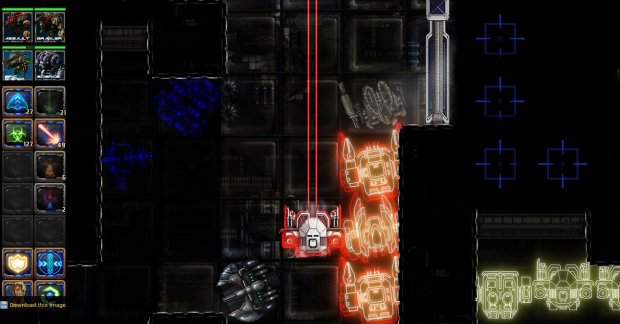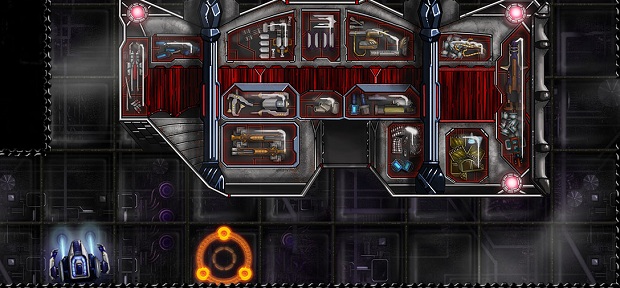Wot I Think: Bionic Dues
Are you a bionic enough dude?
Five minutes of Bionic Dues was almost enough. I was attracted by turn-based tactical mech combat but swiftly repelled by confusion and comedy voiceovers. I quit. Later, just before bed, I decided to try again, reasoning that while Arcen may not be on a winning streak, their games are usually more interesting than this one had seemed. I never did make it to bed that night. Here’s wot I think.
Arcen’s latest is a roguelike with customisable mechs, a giant robot army to defeat and all manner of strange ideas to help it stand out from its turn-based peers and predecessors. It’d stand out even without the ideas but not for the right reasons. Aesthetically, at first glance, Bionic Dues stands out like a thumb so sore that it resembles the spluttering end of a flatulent intestine or a burst wurst. Not only is the initial effect off-putting, the individual parts don’t cohere.
The menu screen greets players with a theme song that sounds like it could be have been chosen for the first dance at a Sailor Moon themed wedding. Character portraits are cartoons that just about fit with the music but not with the rest of the game’s appearance, which is dark and undercooked. And then there are the voices – “why was I programmed to feel pain?” a robot whines as explosions tear it to shreds. Along with the flavour text that accompanies each new piece of loot and item description, the voices aim for the funny bone but I managed to deflect them onto the mute button.
The audio can be easily ignored if it’s not to taste but the graphics present a more formidable obstacle. Menus resemble placeholders, right down to the inclusion of debug tools. Even the choice of character at the beginning of the game offers one with a special power that is essentially an easy mode. The game describes it as the ‘cheesiest’ power. Combined with the obtuse nature of its basic systems, this exposure of the inner mechanics initially made Bionic Dues a frustrating experience. It might be the most fascinating machine in the world but I need to see it running instead of spending my time poking a screwdriver at its circuits.
If it isn’t already obvious, I should make it clear that Bionic Dues is utterly brilliant.
Accept that the graphics, mish-mash that they are, serve to communicate information rather than to court your eyes, and they quickly become tolerable. Before long, they’re useful and a couple of hours in you’ll probably feel affectionate toward the jalopy-bots vibrating and clanking through each of the procedurally generated missions. The graphics, as should be expected in a roguelike, are a functional tileset, designed to convey information swiftly and they perform their job admirably. However, my first attempts to play the game made it seem impenetrable because of the sheer amount of information presented.
The first screen of a new campaign is a city map with a web of missions stretching out from a central point – the player’s HQ. At the left hand side of the screen, a column of buttons provide access to the inventory, shop and mech customisation. It’d be more sensible to have one large garage button because the screens are all linked by tabs and it’s rare that one needs to be used without the others.
Each of the four mechs under the player’s control has a predetermined number of slots in several areas, such as shields, propulsion and computing, and a few low level pieces of equipment are available before the mission even begins. Some consume the limited power available from reactors, others add to it. Many increase the power, range or ammunition load of weapons. They are all randomised, with bizarre tech adjectives taking the place of the usual magical modifiers.
The loot system isn’t too difficult to grasp but the mechs themselves are very strange indeed. All four begin every mission but only one is in play at a time. Switching between them takes one turn but they never exist independently of one another on the same map and as soon as a mission is complete, they return to full power even if they were destroyed. Essentially, this means they work as separate components of the same entity, with changes made to fit circumstances as they arise.
A Science mech is necessary, at least in my experience, as it acts as the lockpicking thief of the group. Often, it’s the only one of the four that can gather loot, by hacking through locked doors to discover containers. It has a limited number of hacks for each mission and they can also be used to ‘consume’ computer terminals, which are equivalent to potions or scrolls, although they can’t be carried. Once used, their function is known for the rest of the game and, as roguelike tradition dictates, their effects can be cruel or kind.
The remaining members of the party are selected from a group of offensive sorts, although in the armament sense rather than in the style of a pier-end comedian. I tend to sally forth with an all-round Assault class, a close range Brawler and a Sniper. The sniper acts as a scout, being my main unit as I search levels for their various objectives, and I switch between the rest as and when they are needed. Or when I screw up and lose the Sniper.
Keeping ever mech intact makes missions easier and also brings more rewards upon completion, but they tend to explode. A lot.
Each mission is fairly short, with maps stretching across a handful of screens and contained on one level. They play out as a cross between the puzzling approach of Desktop Dungeons and a hyper-condensed version of a more conventional dungeon crawler. Enemies are scattered, often in large groups, and wait for the player to come into range before activating. There is also a ‘whistle’ command that alerts everything within audio range.
It’s when enemies become activated that Bionic Dues reveals the deck full of Aces that it has secured in the folds of its raggedy sleeve. Every type of bot has a set of weapons, determining range and damage, and therefore the best manner to approach and eliminate. That’s the basis of the ‘puzzle’ aspect of the game but it’s the AI that drives the enemies that makes every encounter so fascinating. It isn’t ‘clever’ AI, in that it won’t outthink you, but it’s brilliantly designed and almost completely transparent.
Early enemies move or fire randomly, or pack puny weapons but carry ammo to hand to their allies. Later, there are leaders that buff their companions in other ways and heavily armed killbots with predictable but complex movement patterns. Throw a group of diverse bots into a single room and every move feels like a miniature battle of wills. The computer has already shown its hand but it’s drawing from an increasingly complex deck. Read everything on the screen, understand your own abilities, and you’ll probably find a solution, a one-step turn that leads to another dilemma. Rush in and all is lost.
Losing a mech can be frustrating but most of the time, you’ll only have yourself to blame. Losing an entire mission is far worse. I’ve quit and restarted after a single failure. The campaign is punishing, allowing only five mistakes (although reparation is possible) before the whole thing is a bust. Each mission either provides valuable loot to improve your mechs or weakens the final bot army, which arrives after fifty days (one day per mission). When that army does arrive, it’s your four, with whatever insanely powerful upgrades they’ve seized, against a ludicrous number of levelled up killing machines.
I haven’t beaten it. At the moment, I doubt I ever will, but I improve on almost every attempt. Learning how to use stealth intelligently is a huge step, realising that it’s an intentional ‘cheat’, overpowered but limited. Devices and abilities roll into one another, creating a player entity as powerful and complex as the opposition. Instead of picking bots off from a distance, chain reactions of explosions can destroy entire groups, drawing the survivors onto a killing floor, filled with traps and tricks tailored to take advantage of specific weaknesses.
After AI War, Arcen have a lot at the wall but most of it hasn’t stuck. I have a fondness for Shattered Haven, a weird survival horror puzzle adventure, but it contains too many ideas and eventually they smother it. I thought Bionic Dues was going to end up the same way but the roguelike structure, dissected and represented as smaller parcels, holds the various pieces together and allows the good ideas to shine through. And they shine far brighter than I’d expected. This is Arcen’s best work since AI War by quite a distance and, if it finds the right room for expansion, it might well be their finest release to date.
Bionic Dues is out now and there is a demo (Win/OSX/Linux) available. Give it more than five minutes, eh?














